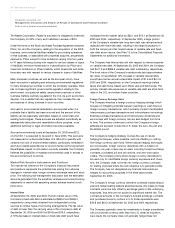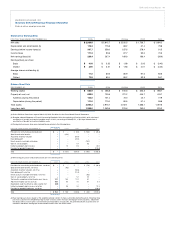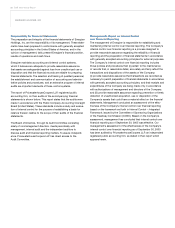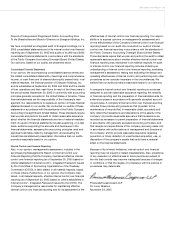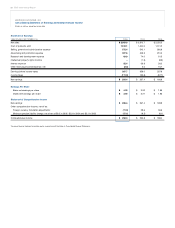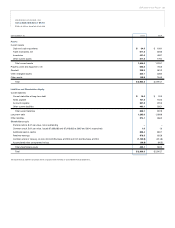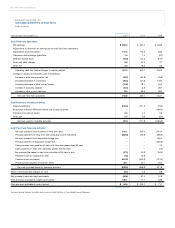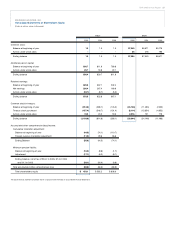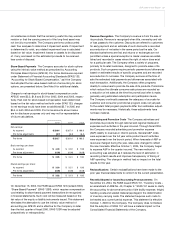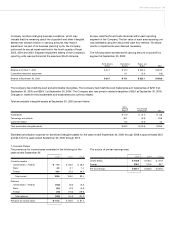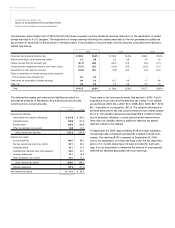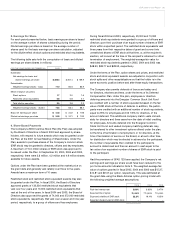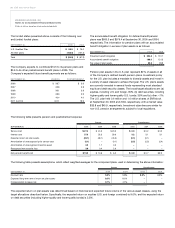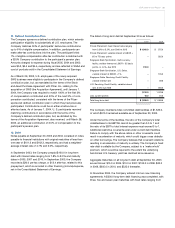Energizer 2005 Annual Report Download - page 28
Download and view the complete annual report
Please find page 28 of the 2005 Energizer annual report below. You can navigate through the pages in the report by either clicking on the pages listed below, or by using the keyword search tool below to find specific information within the annual report.
26 ENR 2005 Annual Report
1. Basis of Presentation
Preparation of the financial statements in conformity with generally
accepted accounting principles in the United States (GAAP) requires
Energizer Holdings, Inc. and its subsidiaries (the Company) to make
estimates and assumptions that affect the reported amounts of
assets and liabilities, disclosure of contingent assets and liabilities
and the reported amounts of revenues and expenses. On an ongoing
basis, the Company evaluates its estimates, including those related
to customer programs and incentives, product returns, bad debts,
inventories, intangible and other long-lived assets, income taxes,
financing, pensions and other postretirement benefits, contingencies
and acquisitions. Actual results could differ from those estimates.
2. Summary of Significant Accounting Policies
The Company’s significant accounting policies, which conform
to GAAP and are applied on a consistent basis among all years
presented, except as indicated, aredescribed below.
Principles of Consolidation The financial statements include the
accounts of Energizer and its majority-owned subsidiaries. All signif-
icant intercompany transactions are eliminated. Investments in affili-
ated companies, 20% through 50% owned, are carried at equity.
Foreign Currency Translation Financial statements of foreign opera-
tions wherethe local currency is the functional currency are translated
using end-of-period exchange rates for assets and liabilities, and
average exchange rates during the period for results of operations.
Related translation adjustments are reported as a component within
accumulated other comprehensive income in the shareholders equity
section of the Consolidated Balance Sheet.
For foreign operations where the U.S. dollar is the functional currency
and for countries that areconsidered highly inflationary, translation
practices differ in that inventories, properties, accumulated depreci-
ation and depreciation expense are translated at historical rates
of exchange, and related translation adjustments are included in
earnings. Gains and losses from foreign currency transactions are
generally included in earnings.
Financial Instruments and Derivative Securities The Company
uses financial instruments, from time to time, in the management
of foreign currency, interest rate and other risks that are inherent to
its business operations. Such instruments arenot held or issued for
trading purposes.
Foreign exchange (F/X) instruments, including currency forwards,
purchased options and zero-cost option collars, are used primarily
to reduce transaction exposures and, to a lesser extent, to manage
other translation exposures. F/X instruments used are selected based
on their risk reduction attributes and the related market conditions.
The terms of such instruments are generally 12 months or less.
For derivatives not designated as hedging instruments for accounting
purposes, realized and unrealized gains or losses from such instru-
ments are recognized currently in other financing (income)/expense,
net in the Consolidated Statement of Earnings. The Company has
not designated any financial instruments as hedges for accounting
purposes in the three years ended September 30, 2005.
Cash Equivalents For purposes of the Consolidated Statement of
Cash Flows, cash equivalents are all considered to be highly liquid
investments with a maturity of three months or less when purchased.
Accounts Receivable Valuation Accounts receivable are stated
at their net realizable value. The allowance for doubtful accounts
reflects the Company’s best estimate of probable losses inherent
in the receivables portfolio determined on the basis of historical
experience, specific allowances for known troubled accounts and
other currently available information. Bad debt expense is included
in selling, general and administrative (SG&A) expense in the
Consolidated Statement of Earnings.
Inventories Inventories are valued at the lower of cost or market,
with cost generally being determined using average cost or the
first-in, first-out (FIFO) method.
Capitalized SoftwareCosts Capitalized softwarecosts areincluded in
Other Assets. These costs areamortized using the straight-line method
over periods of related benefit ranging from three to seven years.
Property at Cost Expenditures for new facilities and expenditures
that substantially increase the useful life of property,including
interest during construction, are capitalized. Maintenance, repairs
and minor renewals areexpensed as incurred. When property is
retired or otherwise disposed of, the related cost and accumulated
depreciation are removed from the accounts, and gains or losses
on the disposition are reflected in earnings. The carrying value of
assets held for disposal under several previous restructuring plans
was $4.6 at September 30, 2005.
Depreciation Depreciation is generally provided on the straight-line
basis by charges to costs or expenses at rates based on estimated
useful lives. Estimated useful lives range from two to 25 years for
machinery and equipment and three to 30 years for buildings.
Depreciation expense was $111.0, $110.0 and $80.5 in 2005, 2004
and 2003, respectively.
Goodwill and Other Intangible Assets Goodwill and indefinite-
lived intangibles are not amortized, but are evaluated annually for
impairment as part of the Company’s annual business planning
cycle in the fourth quarter. The fair value of each reporting unit is
estimated using the discounted cash flow method. Intangible assets
with finite lives are amortized on a straight-line basis over expected
lives of three to 15 years. Such intangibles are also evaluated for
impairment annually.
Impairment of Long-Lived Assets The Company reviews long-
lived assets for impairment when events or changes in business
ENERGIZER HOLDINGS, INC.
Notes to Consolidated Financial Statements
(Dollars in millions, except per share and percentage data)


